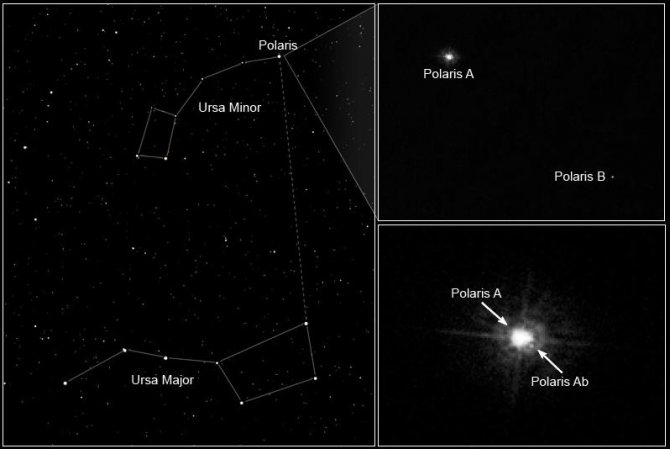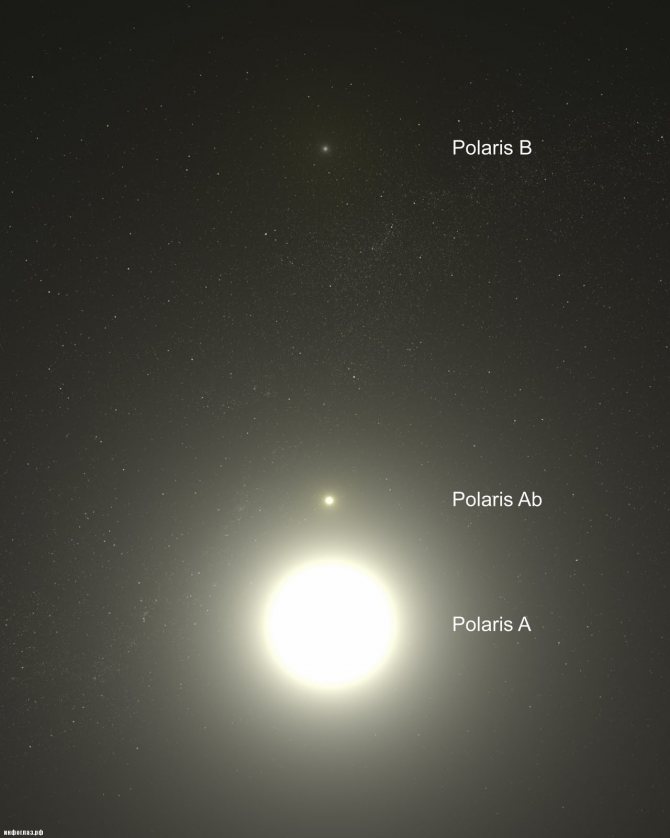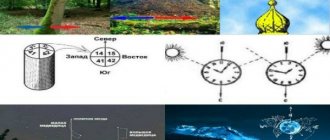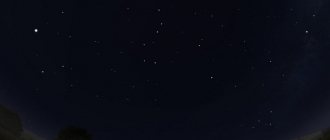Published Olga at 06/07/201906/07/2019
The North Star is probably known to everyone. It is always located on one part of the sky and allows you to accurately determine north. If you know exactly how to find the North Star by its appearance or the location of other constellations, you can navigate the area quite accurately, even without a compass or other instruments at hand.
This article will discuss the main ways to search for this bright point in the sky of the Northern Hemisphere. We hope that these tips will help you accurately and correctly navigate the space.
A way to find the North Star in the sky
North is determined not only by one point, but also by the location of other constellations. Unfortunately, this method of orientation requires certain knowledge of astronomy. Moreover, it is associated with a certain risk: if you incorrectly determine the location of the constellation or completely confuse it with another, you may go in the wrong direction (Figure 1).
Figure 1. The easiest way to find the North Star
To prevent this from happening, orienteering experts still advise finding the North Star in the night sky and only using it to determine the direction of movement.
Fortunately, you don't need any maps or compasses to find it. It is the brightest in the sky, and is located at the end of the Polar Bear. Moreover, if all other constellations gradually move across the sky, then this one hangs motionless, being their center.
Many titles
There is not a single star in the entire galaxy that is more popular than Polaris. many names for it , and all of them are somehow related to its location relative to the Earth.
Many peoples consider this fixed star to be a kind of stake that is driven into the sky, and around which all other celestial bodies revolve. In this regard, such names as “Iron Stake” , “Northern Nail” and “Stake Star” . These names are of Turkic origin. This luminary received its modern name during the reign of Peter I in Russia. The Khakass call this luminary “Tied Horse” and “Hole in the Sky.”
Features and description of the constellation
In order for the North Star, the brightest in the sky, to really help you navigate in space, it is advisable to find out more information about its appearance and features (Figure 2).
Everyone knows that it is brighter than other heavenly bodies. But there are many other bright points in the night sky that can mislead a beginner.
If you carefully observe the night sky, you will notice that all the constellations are gradually moving. This occurs due to the rotation of the Earth around its axis. The North Star, unlike all the others, is practically motionless. It is located in the center of the other clusters. It is thanks to this feature that the brightest luminary always points to the north.

Figure 2. The North Star always points north
Finding the right direction takes just a few simple steps. You need to find it in the sky and draw a visual vertical line from it to the visible horizon. North will be at the intersection. The south, accordingly, will be located behind the viewer, the east - to the right, and the west - to the left.
How to find the North Star by Ursa Major
The easiest way to find the North Star in the night sky is Ursa Major. Of course, there are a lot of visible points in the sky, but in the absence of artificial light sources, they will look much brighter than in the city. Finding the constellation Ursa Major is not difficult, since its bucket is visible in the sky all year round and has a characteristic shape, so even beginners can notice the cluster of night stars (Figure 3).
Outwardly, it seems that Ursa Major consists of only seven points. In fact, there are many more of them, but the brightest are those that give the constellation the shape of a bucket.

Figure 3. The easiest way to find the brightest star is by looking at the Ursa Major bucket
To determine the location of the bright point, you need to find the two rightmost luminaries of the “bucket”. From them you need to lay a horizontal line, and your gaze will rest on a bright point of light. They stand out strongly against the background of other, smaller luminaries. In fact, the North Star is part of the constellation Ursa Minor. It also resembles a ladle in shape, although it is much smaller in size and visually seems to be turned upside down in relation to the Big Dipper. At the end of the “handle” of the second “bucket” is the North Star.
By the way, the location of the constellations largely depends on the season. In winter, the Big Dipper seems to stand on its “handle”, shifting to the east, in the spring it is almost at the zenith, and in the summer it completely moves to the center of the sky. That is why, in the warm season, novice astronomers often have difficulty finding the main constellation of the Northern Hemisphere.
Main characteristics of the object
It can be unequivocally stated that it is the brightest and closest to Earth. The luminary has a pulsating, variable character. The period is 3.97 days. However, it has a number of non-standard qualities:
- its pulsations are subject to attenuation, and this happens over several decades;
- in 1900 the brightness changed by 8%, while in 2005 this value was 2%;
- for the entire time it has been known to science, the brightness has increased by 15%;
- this is not a separate star, but a triple system, including the Alpha supergiant and two other elements;
- there is a possibility that Polaris and the other bright objects that surround it act as a remnant of an open cluster.
Since the distance is still in question, there is a risk of inaccurate measurements of distances to other galaxies. Therefore, its clarification will make it possible to determine distance scales and make more accurate calculations regarding a number of other characteristics.

The North Star and its companions.
Using a compass and map
The starry sky is not always perfectly open for viewing. The horizon may be obscured by trees, hills, or clouds. If identifying the North Star is vital, you can use a map and compass (Figure 4).
Keep in mind that the magnetic compass needle points in approximately the same direction as the North Star. In this case, corrections should be made for the magnetic pole and distortion from magnetic lines. This indicator is called the magnetic declination of the area, which can be found in a special reference book.
To determine the North North Star using a compass, do the following:
- Use a compass to find north and correct for magnetic declination. For example, if the magnetic declination is western and is 15 degrees, then from the northern end of the compass needle you need to move the exact same number of degrees to the left. It is in this direction that the North Star will be located.
- It is important to choose a suitable location for taking measurements. Do not test near power lines, vehicles or railroad tracks as they may interfere with readings.
- For accurate orientation, you need to determine the height of the luminary. It is measured in degrees and is approximately equal to the latitude of the area. This method allows you to more accurately determine the coordinates of the observer.

All of these methods of orientation are considered extreme, and although they allow you to determine the direction quite accurately, they are still not perfectly accurate.
Historical information about the luminary
The North Star received its name due to its importance in the process of celestial navigation. After all, the distance between it and the world pole is only 0.7 degrees. Alternative names are also available. The most common of them translated means “Tail of the Dog.” This luminary has been used since late antiquity. With its help, it was not difficult to find the direction to the north and find out the latitude.
In the 1st millennium BC, Beta MM acted as the brightest element. She was closest to the celestial pole. However, due to the great distance, she could not become the closest. However, by the efforts of one Greek navigator in 320 BC, the celestial pole was described as devoid of any luminous objects. As for the luminary with the name “Alpha,” ancient scientists wrote that it was always visible.
The name "Polar Star" became assigned to the luminary "Alpha". At least, this is the picture that has developed since the 16th century. This object reaches its maximum declination at 0.4603 degrees from the north pole of the sky (2012, February). The highest declination (0.4526 C) is expected on March 24, 2100.
How to find the North Star in the sky using Cassiopeia
The easiest way to find the North Star in the sky is with the help of Ursa Major, but if you have some skills in astronomy, you can determine its location using other constellations (Figure 5).

Figure 5. Cassiopeia - another bright and noticeable constellation
Another well-known cluster, Cassiopeia, will help in the search for the northern direction. It is located on the opposite side of the “bucket”. In fact, Polar is sandwiched between the Big Dipper and Cassiopeia, so finding it won’t be too difficult.
The search is carried out like this:
- You need to draw a visual line through the two extreme points of the “bucket”.
- Similar actions should be performed with luminaries on the other side of the constellation.
- From the intersection of these two visual lines, draw a ray through the middle part of Cassiopeia. It is in this direction that the North Star will lie.
If you have an accurate eye, then finding the main night star of the Northern Hemisphere will not be difficult at all. Just find Cassiopeia and draw a segment from its center equal to two distances between the extreme points of the constellation. If everything was done correctly, you will definitely stare at the North Star.
Much depends on the geographic coordinates at which the observation is carried out. For example, in the summer, near the equator, the “bucket” lies below the horizon and is not visible to the average observer. At the same time, Cassiopeia and Polaris are visible, so finding them using the method described above will not be difficult.
General descriptive parameters
The North Star is larger in size compared to the Sun. It includes the main star and two minor satellites, the same number of distant elements. One of them was discovered by W. Herschel in 1780. The luminary is part of the Ursa Minor group. It is popular among lovers of astronomical science. This is due to its visibility and beautiful legendary stories.
One of the most pressing topics raised in scientific circles concerns the distance of a subject from our Solar System. Despite an impressive amount of research, nothing is still known about this distance. According to the latest estimates, it is 434 sv. years or 133 parsecs. But some scientists say that there is a possibility that it will be closer to us, for example, by 30%.
In any case, the North Star is located 1 degree (or even less) from the north pole, therefore it is practically motionless during the daily movement of the sky. It offers particular convenience when navigating the terrain, because the direction to it is almost identical to the direction to the north. And the level of height above the horizon is equal to the latitude of the place from which the observation occurs.
Due to the phenomenon of precession in relation to the earth's axis, the North Pole is changeable in its position. Therefore, the Polar Star was closest to it in the period of time from March 7 to June 13, 2012. After this, the removal process began. Thus, according to scientists’ forecasts, by the middle of 2260 the remoteness will exceed the 1C mark. As for the southern hemisphere, the bright Polaris is absent.

Characteristics of the North Star
Landmark by the star Cygnus
The method of searching for the North Star using Cygnus can hardly be called simple, although it is also considered very effective. Its main difficulty is that not everyone finds the Swan in the night sky the first time. However, if you know exactly how to find it, determining the north direction will not cause difficulties, even if part of the sky and the North Star itself are hidden behind the clouds (Figure 6).

Figure 6. Searching for the constellation Cygnus is considered difficult
To do this, you need to find the two lowest points of the cluster: Hyena and Deneb. You need to draw a visual line between them. A segment is laid from Deneb, the length of which must correspond to two distances between the lower luminaries. At the end of this line the brightest point in the Northern Hemisphere is found.
Search by Orion
Finding the North Star using Orion is also difficult, although it is quite possible with certain skills. This method will help with orientation if part of the sky is covered with clouds and it is difficult to find the north (Figure 7).
To do this, you will need not only Orion's belt, but also its extreme point - Capella. To do this, you need to draw a visual beam through the center of the belt, or more precisely, through the star Meissa. This section is then extended to the Capella and beyond. At the end of such a visual line the North Star will be located.

Figure 7. Orion searches are carried out only in autumn and winter
It is important that this method can only be used in autumn and winter. It is at this time of year that parts of Orion and the Polar Point are located at a distance from each other that allows one to determine the north. Moreover, the belt appears in the sky in the Northern Hemisphere only at this time of year.
The structure of the Polaris star system

Alphas of Ursa Minor, taken by the Hubble Telescope
α UMi Aa or the North Star, is known for being 4.5 times the Sun in mass and having a spectral class of F7, which classifies it as a supergiant (Ib). It is the first classical Cepheid to have the ability to measure its mass directly, thanks to the presence of satellites.
The two smaller companions: α Umi B, weighs 1.39 solar masses and has a spectral class of F3, are at a distance of 2400 AU, and α Umi Ab, a very close class F6 main sequence star with an orbital radius of 18.8 AU and weighs 1.26 solar masses. There are also two distant components α Umi C and α Umi D, but they are not physically connected with Polar.

Polaris system, drawing
Polar B (α UMi B) can be seen even with a modest telescope. It turned out that it was observed by William Herschel in 1780 using one of the most powerful telescopes at that time - a reflecting telescope of his own construction. In 1929, it was discovered by studying the spectrum that Polaris A is a very close double containing a faint star (α Umi Ab). In January 2006, NASA released images from the Hubble Telescope directly showing all three members of the triple system. The closest star to Polaris is at 18.5 AU. (2.8 billion km) from it and this explains why we saw the light of the smaller satellite only in 2006.











